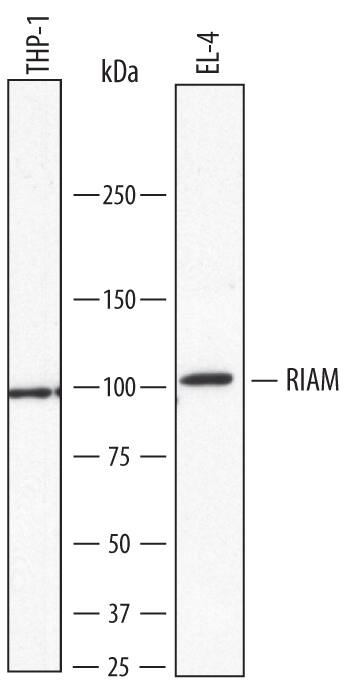Human/Mouse RIAM/APBB1IP Antibody
R&D Systems, part of Bio-Techne | Catalog # AF7279

Key Product Details
Species Reactivity
Validated:
Cited:
Applications
Validated:
Cited:
Label
Antibody Source
Product Specifications
Immunogen
Gly2-Ser89
Accession # Q7Z5R6
Specificity
Clonality
Host
Isotype
Scientific Data Images for Human/Mouse RIAM/APBB1IP Antibody
Detection of Human and Mouse RIAM/APBB1IP by Western Blot.
Western blot shows lysates of THP-1 human acute monocytic leukemia cell line and EL-4 mouse lymphoblast cell line. PVDF membrane was probed with 1 µg/mL of Sheep Anti-Human RIAM/APBB1IP Antigen Affinity-purified Polyclonal Antibody (Catalog # AF7279) followed by HRP-conjugated Anti-Sheep IgG Secondary Antibody (Catalog # HAF016). A specific band was detected for RIAM/APBB1IP at approximately 100-110 kDa (as indicated). This experiment was conducted under reducing conditions and using Immunoblot Buffer Group 8.RIAM/APBB1IP in Wi-38 Human Cell Line.
RIAM/APBB1IP was detected in immersion fixed Wi-38 human lung fibroblast cell line using Sheep Anti-Human RIAM/APBB1IP Antigen Affinity-purified Polyclonal Antibody (Catalog # AF7279) at 10 µg/mL for 3 hours at room temperature. Cells were stained using the NorthernLights™ 557-conjugated Anti-Sheep IgG Secondary Antibody (red, upper panel; Catalog # NL010) and counterstained with DAPI (blue, lower panel). Specific staining was localized to cytoplasm. View our protocol for Fluorescent ICC Staining of Cells on Coverslips.Applications for Human/Mouse RIAM/APBB1IP Antibody
Immunocytochemistry
Sample: Immersion fixed Wi-38 human lung fibroblast cell line
Western Blot
Sample: THP‑1 human acute monocytic leukemia cell line and EL‑4 mouse lymphoblast cell line
Formulation, Preparation, and Storage
Purification
Reconstitution
Formulation
Shipping
Stability & Storage
- 12 months from date of receipt, -20 to -70 °C as supplied.
- 1 month, 2 to 8 °C under sterile conditions after reconstitution.
- 6 months, -20 to -70 °C under sterile conditions after reconstitution.
Background: RIAM/APBB1IP
APBB1IP (Amyloid beta A4 precursor protein-binding family B member 1 interacting protein; also PREL-1, Pro-rich protein 73, RARP1 and RIAM) is a member of the MRL family of proteins. Although its predicted MW is 73 kDa, it runs anomalously at 100-110 kDa in SDS-PAGE. It is expressed in megakaryocytes, T cells and fibroblasts. APBB1IP acts as a coordinator for Rap1 GTPase signaling. Rap1 both antagonizes Ras signaling, and is associated with beta1 and beta2 integrin-induced cell adhesion and cytoskeleton rearrangement. Within this context, APBB1IP operates as a cytosolic adaptor protein that induces integrin activation by recruiting talin and RAP1 to the cell membrane, and by mediating Profilin and VASP protein polymerizatiuon of actin. Human APBB1IP is 666 amino acids (aa) in length. It contains a poly-Pro sequence (aa 129-148), a Ras-association domain (aa 176-263), a PH domain (aa 310-419), and a large poly-Pro region (aa 503-640). There are multiple potential isoform variants. One contains a deletion of aa 152-177 coupled to a 27 aa substitution for aa 262-666, a second possesses a 21 aa substitution for aa 152‑666, and a third shows a deletion of aa 386-390 coupled to a five aa substitution for aa 417-666. Over aa 2-89, human APBB1IP shares 97% aa sequence identity with mouse APBB1IP.
Long Name
Alternate Names
Gene Symbol
UniProt
Additional RIAM/APBB1IP Products
Product Documents for Human/Mouse RIAM/APBB1IP Antibody
Product Specific Notices for Human/Mouse RIAM/APBB1IP Antibody
For research use only

